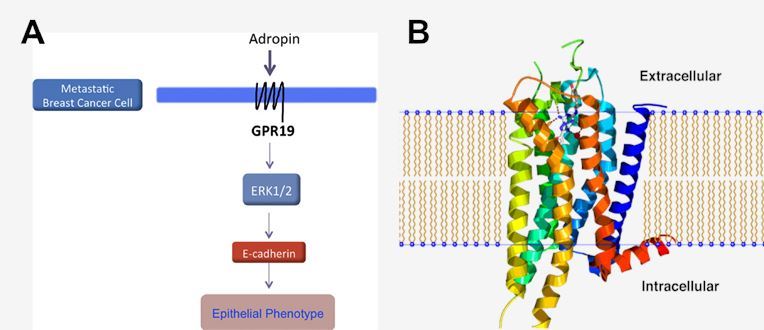Introduction of GPR19
GPR19 is encoded by the GPR19 gene, also known as GPR-NGA. Based on its sequence, GPR19 is a member of G protein-coupled receptors (GPCRs) family which is involved in many diseases. It is one of a class A orphan GPCRs which have similar structures to other identified GPCRs but whose endogenous ligand has not yet been identified. GPR19 was first identified and cloned in 1996 by screening a human expressed sequence tag (EST) database, but little is known about its functional and pathological relevance.
| Basic Information of GPR19 | |
| Protein Name | Probable G-protein coupled receptor 19 |
| Gene Name | GPR19 |
| Aliases | GPR-NGA |
| Organism | Homo sapiens (Human) |
| UniProt ID | Q15760 |
| Transmembrane Times | 7 |
| Length (aa) | 415 |
| Sequence | MVFAHRMDNSKPHLIIPTLLVPLQNRSCTETATPLPSQYLMELSEEHSWMSNQTDLHYVLKPGEVATASIFFGILWLFSIFGNSLVCLVIHRSRRTQSTTNYFVVSMACADLLISVASTPFVLLQFTTGRWTLGSATCKVVRYFQYLTPGVQIYVLLSICIDRFYTIVYPLSFKVSREKAKKMIAASWVFDAGFVTPVLFFYGSNWDSHCNYFLPSSWEGTAYTVIHFLVGFVIPSVLIILFYQKVIKYIWRIGTDGRTVRRTMNIVPRKVKTIKMTFLILNLLFLLSWLPFHVAQLWHPHEQDYKKSSLVFTAITWISFSSSASKPTLYSIYNANFRRGMKETFCMSSMKCYRSNAYTITTSSRMAKKNYVGISEIPSMAKTITKDSIYDSFDREAKEKKLAWPINSNPPNTFV |
Function of GPR19 Membrane Protein
GPR19 lacks a defined biological or physio-pathological function, but a few studies provide relative evidence to support that GPR19 plays an oncogenic role in some types of cancer. It belongs to a set of genes with a high expression in metastatic melanoma samples according to the microarray analysis of about 40 metastatic melanoma patients’ samples. It has been demonstrated that the expression of GPR19 is high in glioblastoma stem-like cells and small cell lung cancer tissues. GPR19 plays a potential role in metastasis by promoting the mesenchymal-epithelial transition to facilitate metastatic colonization of breast tumors. GPR19 signaling can activate the ERK/MAPK pathway and is essential for the changes of epithelial cells. Additionally, GPR19 and few other neuronal orphan GPCR's have also been demonstrated to be activated by plasmalogens and to elevate the level of Akt and ERK phosphorylation. These studies taken together indicate that the elevated expression of GPR19 may be associated with metastasis and survival of cancer cells mechanistically.
 Fig.1 The signaling pathway of GPR19 and the schematic diagram of a GPCR. (Rao, 2017)
Fig.1 The signaling pathway of GPR19 and the schematic diagram of a GPCR. (Rao, 2017)
Application of GPR19 Membrane Protein in Literature
This article reveals that GPR19 plays a potential role in metastasis in mediating the mesenchymal-epithelial transition (MET) to facilitate the colonization of metastatic breast tumor cells through the ERK/MAPK pathway for the first time.
Authors in this group apply RNA interference method to knockdown of GPR19 mRNA in human lung cancer cells to demonstrate that GPR19 as a potential candidate target for treating the lung cancer.
This article reports that the orphan G protein-coupled receptor, GPR19 has a physical association of adropin in the central nervous system and GPR19 could to be a candidate receptor for adropin.
This article focuses on evaluating the biological function of orphan class-A G-protein coupled receptors in the cAMP signaling pathway. It shows that the cAMP dependent constitutive activity was observed in GPR19 transiently expressed CHO-K1 cells because the gene expression of GPR19 has 200% elevation over baseline receptor.
This article evaluates the regulated gene expression of GPR19 during adult mouse brain embryonic development. It indicates that GPR19 plays a protective role during the early development of the nervous system because of its most characteristic effects.
GPR19 Preparation Options
To obtain the soluble and functional target protein, the versatile Magic™ membrane protein production platform in Creative Biolabs enables many flexible options, from which you can always find a better match for your particular project. Aided by our versatile Magic™ anti-membrane protein antibody discovery platform, we also provide customized anti-GPR19 antibody development services.
Creative Biolabs is a leading customer service provider with good reputation for successfully accomplishing numerous challenging projects including generation of many functional membrane proteins to our worldwide customers. Please feel free to contact us if you have any questions and suggestions.
Reference
All listed services and products are For Research Use Only. Do Not use in any diagnostic or therapeutic applications.